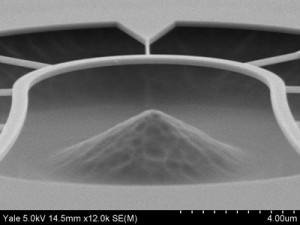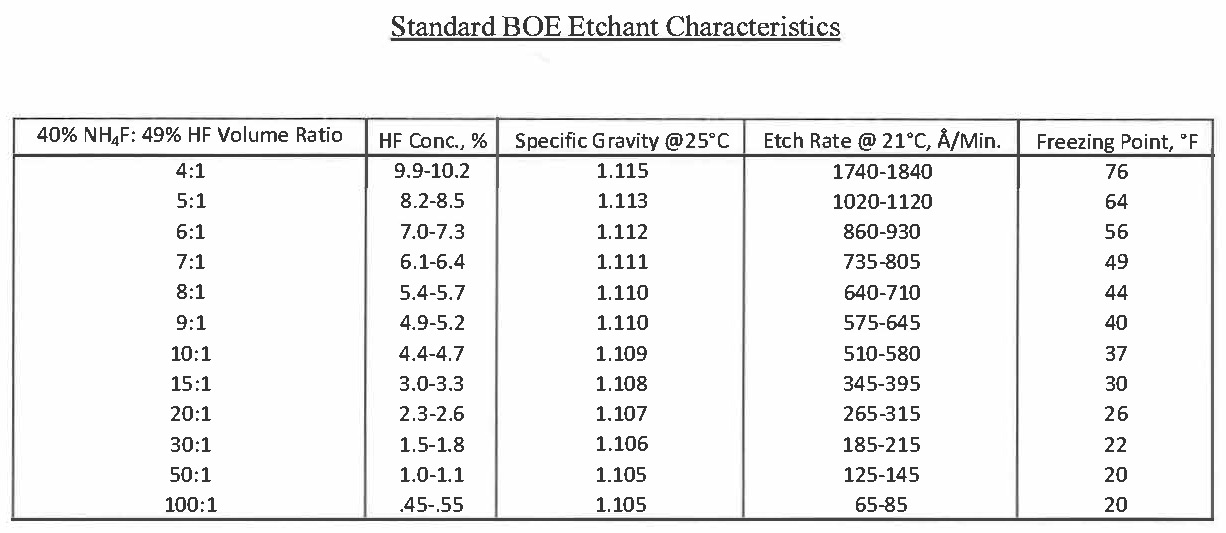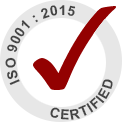Silicon Dioxide (SiO2) Etchants
High purity buffered HF etchants for thermally grown or deposited silicon dioxide films. Transene silicon dioxide etchants are ideal for semiconductor applications requiring minimal undercutting and broad compatibility. Buffered Oxide Etchants ship standard without surfactant. Non-PFAS surfactant added upon request.
BUFFER-HF-IMPROVED
Highest etch rate for thermally grown silicon dioxide films. Also suitable for deposited SiO2.
BD ETCHANT
Buffered dip etchant for polysilica glass (PSG) and borosilica glass (BSG) systems. The etch rate is variable depending upon PSG or BSG composition.
TIMETCH
Optimum control for etching of deposited silicon dioxide films.
SILOX VAPOX III
Etches deposited oxides on silicon. Saturated with aluminum to minimize attack on metallic substrates.
FEATURES:
- Wide range of etch rates
- High purity
- Ready to use
- Broad compatibility with photoresists
Buffer HF Improved

1.0 micron silicon dioxide film etched with Buffer HF Improved for 30 minutes at 25°C. Courtesy of Yale University
FLUORIDE – BIFLUORIDE – HYDROFLUORIC ACID BUFFER
Improved HF buffer system with stabilized HF activity – selective solvent for SiO2 used in semiconductor technology of planar passivated devices – transistors, integrated circuits, diodes, rectifiers, SCR, MOS, FET.
UNIQUE ADVANTAGES
- Ready-to-use
- Economical
- HF activity buffer stabilized
- Excellent process reproducibility
- Does not undercut masked oxide
- Will not stain diffused silicon surfaces
- Avoids contamination on silicon surfaces
- Photoresist compatibility
Literature Citation Referencing Application of Buffer HF Improved
BUFFER HF IMPROVED
DESCRIPTION
BUFFER HF IMPROVED is an idealized buffer preparation characterized by a high buffer index and an optimized, uniform oxide-etch rate. The composition of BUFFER HF IMPROVED is precisely controlled by HF activity measurements and electrometric pH. The mass balance corresponds essentially to HF + F + 2(HF2) for a two-ligand mononuclear complex and the charge balance is (H+) – (F) + (HF2– ). The HF activity is maintained constant through the specific equilibrium constant, which regulates the equilibrium reaction between fluoride, bifluoride, and HF buffer components. A second equilibrium constant participates in the regulation of the hydronium ion concentration.
BUFFER HF IMPROVED is produced and analyzed to be essentially free of impurities. Nitrate ions, a common impurity causing stains on diffused silicon surfaces, are specifically removed. Heavy metal impurities, which can lead to degradation of device characteristics, are rigidly controlled under manufacturing process specifications.
Properties of Buffer HF Improved
| How do I increase the etch rate? | 1. The rate will approximately double with every 10°C increase in temperature. 2. Increase the rate of stirring or agitation. |
| How do I reduce the etch rate? | Adding 1 part deionized water to 2 parts etchant will reduce the etch rate approximately 50%. |
| Do I need to dilute the etchant? | No, it is ready to use. |
| How do I reduce undercutting? | Increase the rate of stirring or agitation. |
| Appearance | Water-white |
| pH | ~4 |
| Etch Rate at 20°C | 800 Å/min. * |
| Etch Capacity (rate declines at ~70%) | 65 g/gallon |
| Shelf Life | 1 year |
| Storage Conditions | Room temperature:crystallization occurs below 10oC; warm with agitation to re-dissolve crystals |
| Filtration | 0.2 um |
| Recommended Operating Temperatures | 20-80oC (30-40oC most common) |
| Rinse | Deionized water; may be followed by alcohol rinse if desired. |
| Photoresist Recommendations | KLT6000 Series, KLT 5300 Series, HARE SQ (SU-8 type), TRANSIST, or PKP Type II |
| Select Compatible Materials | Gold, copper, nickel
See https://transene.com/etch-compatibility/ for more details. |
| Select Incompatible Materials | Glass, titanium, alumina, silicon nitride |
| Compatible Plastics | HDPE, PP, Teflon, PFA, PVC |
| Country of Origin | USA |
| Availability | Stock item |
| Available Sizes | Quart, Gallon, 5 Gallon, 55 Gallon |
| Packaging | HDPE |
| Packing | 4 gallons/case |
| Isotropy | Isotropic |
| Incompatible Chemicals | Strong acids |
| Additional Information | Poison—use extreme caution |
* Etch rate may vary depending upon Silica film structure
USE OF BUFFER HF IMPROVED
BUFFER HF IMPROVED dissolves silica films (both thermally grown and silane SiO2) produced on the surfaces of silicon and exposed by photolithography. It also is capable of dissolving doped silica films such as phosphosilica and borosilica glasses as formed in semiconductor processing. The overall chemical reaction is: 4HF + SiO2 -> SiF4 + 2H2O
For trouble-free operation BUFFER HF IMPROVED is recommended in the new technologies for manufacture of semiconductor planar and mesa devices. it is compatible with both negative and positive photoresists. Excellent results with good reproducibility are simple to achieve without undercutting marked oxides, surface staining or device degradation by metallic impurities.
INSTRUCTIONS
Most practical oxide passivation layers range from 2000 Å to 5000 Å in thickness, and good results are obtained by exposure in BUFFER HF IMPROVED for 2 to 5 minutes at room temperature. Exposure time may be decreased or increased if necessary. BUFFER HF IMPROVED should be rinsed off with deionized water. The high buffer index of BUFFER HF IMPROVED permits repeated use of the buffer at fixed exposure time. For faster etch rate (approx. 2X) use BUFFER HF IMPROVED at 35 °C.
SILICON DIOXIDE THICKNESS VS. REFLECTED COLOR
| COLOR | THICKNESS | Å X 103 | ||||||
| gray,tan,brown | 0.1 | 0.3 | 0.5 | — | — | |||
| blue | 0.8 | 1.5 | 3.0 | 4.9 | 6.9 | |||
| violet | 1.0 | 2.7 | 4.7 | 6.5 | — | |||
| green | 1.9 | 3.3 | 5.2 | 7.2 | — | |||
| yellow | 2.1 | 3.7 | 5.6 | 7.5 | — | |||
| orange | 2.2 | 4.0 | 6.0 | — | — | |||
| red | 2.5 | 4.4 | 6.3 | — | — | |||
Buffered Oxide Etchants
Standard blends of high purity ammonium fluoride and hydrofluoric acid in standard and customized ratios.
Typical Specifications:
| Assay Parameter | Unit | Specification | ||||
| Color | APHA | <=10 | ||||
| Particles > 1.0 micron | #/mL | ≤ 15 | ||||
| Chloride | ppm | <=2 | ||||
| Nitrate | ppm | <=3 | ||||
| Phosphate | ppm | <=0.4 | ||||
| Sulfate | ppm | <=0.5 | ||||
| Particles >0.5 | Particle/ml | <=100 | ||||
| Particles >1.0 | Particle/ml | <=20 | ||||
| Aluminum | ppb | <=3.1 | ||||
| Antimony | ppb | <=12 | ||||
| Arsenic | ppb | <=3 | ||||
| Barium | ppb | <=0.5 | ||||
| Beryllium | ppb | <=1 | ||||
| Bismuth | ppb | <=1 | ||||
| Boron | ppb | <=5 | ||||
| Cadmium | ppb | <=1 | ||||
| Calcium | ppb | <=3 | ||||
| Chromium | ppb | <=2 | ||||
| Cobalt | ppb | <=2 | ||||
| Copper | ppb | <=5 | ||||
| Gallium | ppb | <=2 | ||||
| Germanium | ppb | <=2 | ||||
| Gold | ppb | <=2 | ||||
| Iron | ppb | <=5 | ||||
| Lead | ppb | <=2 | ||||
| Lithium | ppb | <=1 | ||||
| Magnesium | ppb | <=1 | ||||
| Manganese | ppb | <=2 | ||||
| Molybdeum | ppb | <=1 | ||||
| Nickel | ppb | <=1 | ||||
| Potassium | ppb | <=2 | ||||
| Silver | ppb | <=1 | ||||
| Sodium | ppb | <=5 | ||||
| Strontium | ppb | <=1 | ||||
| Thallium | ppb | <=2 | ||||
| Tin | ppb | <=2 | ||||
| Titanium | ppb | <=5 | ||||
| Vanadium | ppb | <=2 | ||||
| Zinc | ppb | <=2 | ||||
| Zirconium | ppb | <=2 | ||||
| Assay Values for Common Blends | ||||||
| Other ratios available upon request | ||||||
| BOE Ratio | NH4F Assay | HF Assay | ||||
| 5:1 | 32-34 | 8.2-8.5 | ||||
| 6:1 | 32-36 | 7.0-7.3 | ||||
| 7:1 | 33.8-35.8 | 6.1-6.4 | ||||
| 10:1 | 34-38 | 4.4-4.7 | ||||
| 20:1 | 37.5-38.5 | 2.3-2.6 |

BD Etchant
FOR PSG-SiO2 SYSTEMS
An improved buffered etch formulation for delineation of phosphosilica glass – SiO2 (PSG), and borosilica glass – SiO2 (BSG) systems, in the passivation of transistor surfaces. BD Etchant has a low PSG/SiO2 ratio, minimizing the undercutting of the PSG passivating film.
ETCH CHARACTERISTICS OF BD ETCHANT
| 20 °C | 25 °C | 30 °C | |
| Dielectric Material | Å/sec. | Å/sec | Å/sec |
| Thermally grown SiO2 | 0.87 | 1.22 | 1.72 |
| PSG (6 mole % P2O5) | 1.85 | 2.47 | 3.35 |
| Etch Ratio (PSG/SiO2) | 2.12 | 2.02 | 1.95 |
Note: etch rate is dependent upon composition of PSG and BSG.
APPLICATION:
Employed as a dip etch to remove SiO2 films from contacts without the disturbance of the PSG film. BD Etchant is used prior to metallization of the contact holes of the silicon transistor wafers followed by water and alcohol rinses.
| How do I increase the etch rate? | 1. The rate will approximately double with every 10°C increase in temperature. 2. Increase the rate of stirring or agitation. |
| How do I reduce the etch rate? | Adding 1 part deionized water to 2 parts etchant will reduce the etch rate approximately 50%. |
| Do I need to dilute the etchant? | No, it is ready to use. |
| How do I reduce undercutting? | Increase the rate of stirring or agitation. |
| Appearance | Water-white |
| pH | Mild alkaline |
| Etch Rate at 25°C 30°C |
1.22 Å/sec. 1.72Å/sec |
| Etch Capacity (rate declines at ~70%) | 60 g/gallon |
| Shelf Life | 1 year |
| Storage Conditions | Ambient |
| Filtration | 0.2 um |
| Recommended Operating Temperatures | 20-80oC (30-40oC most common) |
| Rinse | Deionized water; may be followed by alcohol rinse if desired. |
| Photoresist Recommendations | PKP II, HARE SQ (SU-8 type) |
| Select Compatible Materials | Gold, copper, nickel
See https://transene.com/etch-compatibility/ for more details. |
| Select Incompatible Materials | Silicon oxide, silicon nitride, aluminum oxide |
| Compatible Plastics | HDPE, PP, Teflon, PFA, PVC |
| Country of Origin | USA |
| Availability | Stock item |
| Available Sizes | Quart, Gallon, 5 Gallon, 55 Gallon |
| Packaging | HDPE |
| Packing | 4 gallons/case |
| Isotropy | Isotropic |
| Incompatible Chemicals | — |
| Additional Information | — |
Timetch
Controlled Etchant for Silicon Dioxide Films
TIMETCH is a specially prepared etchant solution offering excellent control in the etching process of silicon dioxide, without undercutting. TIMETCH is compatible with negative and positive photoresists.
TIMETCH is used for the removal of silicon dioxide and for the control of oxide thickness of MOS devices. The product is also recommended for the removal of surface oxide of diode and transistor devices prior to metallizations.
Rate of oxide removal is 1.5 Å/second at room temperature for deposited oxides. The rate is somewhat slower for thermal oxide. The etch process is followed by rinsing with distilled deionized water. Timetch is compatible with copper.
PROPERTIES OF TRANSENE TIMETCH ETCHANT /strong>
| How do I increase the etch rate? | 1. The rate will approximately double with every 10°C increase in temperature. 2. Increase the rate of stirring or agitation. |
| How do I reduce the etch rate? | Adding 1 part deionized water to 2 parts etchant will reduce the etch rate approximately 50%. |
| Do I need to dilute the etchant? | No, it is ready to use. |
| How do I reduce undercutting? | Increase the rate of stirring or agitation. |
| Appearance | Water-white |
| pH | Mild alkaline |
| Etch Rate at 25°C | 1.5 Å/sec |
| Etch Capacity (rate declines at ~70%) | 60 g/gallon |
| Shelf Life | 1 year |
| Storage Conditions | Ambient |
| Filtration | 0.2 um |
| Recommended Operating Temperatures | 20-80oC (30-40oC most common) |
| Rinse | Deionized water; may be followed by alcohol rinse if desired. |
| Photoresist Recommendations | PKP II, HARE SQ (SU-8 type) |
| Select Compatible Materials | Gold, copper, nickel
See https://transene.com/etch-compatibility/ for more details. |
| Select Incompatible Materials | Silicon oxide, silicon nitride, aluminum oxide |
| Compatible Plastics | HDPE, PP, Teflon, PFA, PVC |
| Country of Origin | USA |
| Availability | Stock item |
| Available Sizes | Quart, Gallon, 5 Gallon, 55 Gallon |
| Packaging | HDPE |
| Packing | 4 gallons/case |
| Isotropy | Isotropic |
| Incompatible Chemicals | — |
| Additional Information | — |
Silox Vapox III
- This etchant is designed to etch deposited oxides on silicon surfaces. These oxides are commonly grown in vapox silox or other LPCVD devices and differ radically from their thermally grown cousins in many important ways. One way is their etch rate another is their process utility. The deposited oxide is many times used as a passivation layer over a metallized silicon substrate. Silox Vapox Etchant III has been designed to optimize etching of a deposited oxide used as a passivation layer over an aluminum metallized silicon substrate. This etchant has been saturated with aluminum to minimize its attack on the metallized substrate.
- Deposited Oxide (Vapox/Silox) Etch Rate:4000 Å / minute @ 22 °C
- This product contains:
Ammonium Fluoride
Glacial Acetic Acid
Aluminum corrosion inhibitor
Surfactant
DI Water
PROPERTIES OF TRANSENE SILOX VAPOX III
| How do I increase the etch rate? | 1. The rate will approximately double with every 10°C increase in temperature. 2. Increase the rate of stirring or agitation. |
| How do I reduce the etch rate? | Adding 1 part deionized water to 2 parts etchant will reduce the etch rate approximately 50%. |
| Do I need to dilute the etchant? | No, it is ready to use. |
| How do I reduce undercutting? | Increase the rate of stirring or agitation. |
| Appearance | Clear, colorless |
| pH | Acidic |
| Etch Rate at 22°C | 4,000 Å/minute |
| Etch Capacity (rate declines at ~70%) | 65 g/gallon |
| Shelf Life | 1 year |
| Storage Conditions | Ambient |
| Filtration | 1 um |
| Recommended Operating Temperatures | 20-80oC (30-40oC most common) |
| Rinse | Deionized water |
| Photoresist Recommendations | KLT6000 Series, KLT 5300 Series, HARE SQ (SU-8 type), TRANSIST, or PKP II |
| Select Compatible Materials | Au, Cr, Ni, Cu
See https://transene.com/etch-compatibility/ for more details. |
| Select Incompatible Materials | Oxide, nitride, alumina, Ti |
| Compatible Plastics | HDPE, PP, Teflon, PFA, PVC |
| Country of Origin | USA |
| Availability | 1-2 days |
| Available Sizes | Quart, Gallon, 5 Gallon, 55 Gallon |
| Packaging | HDPE |
| Packing | 4 gallons/case |
| Isotropy | Isotropic |
| Incompatible Chemicals | Strong bases |
| Additional Information | — |
AlPAD Etch 639
I. AlPAD Etch 639 is an oxide etchant designed to minimize attack on aluminum pads or other aluminum structures and on silicon surfaces. These oxides are commonly grown in vapox silox or other LPCVD devices. The deposited oxide is often used as a passivation layer over a metallized silicon substrate. The formulation of AlPAD Etch 639 includes a surfactant to ensure wetout over high surface energy substrates.
II. Deposited Oxide (Vapox/Silox) Etch Rate: 5000 A / minute @ 22oC
III. This product contains:
Ammonium Fluoride
Glacial Acetic Acid
Glycol
Surfactant
Deionized Water

